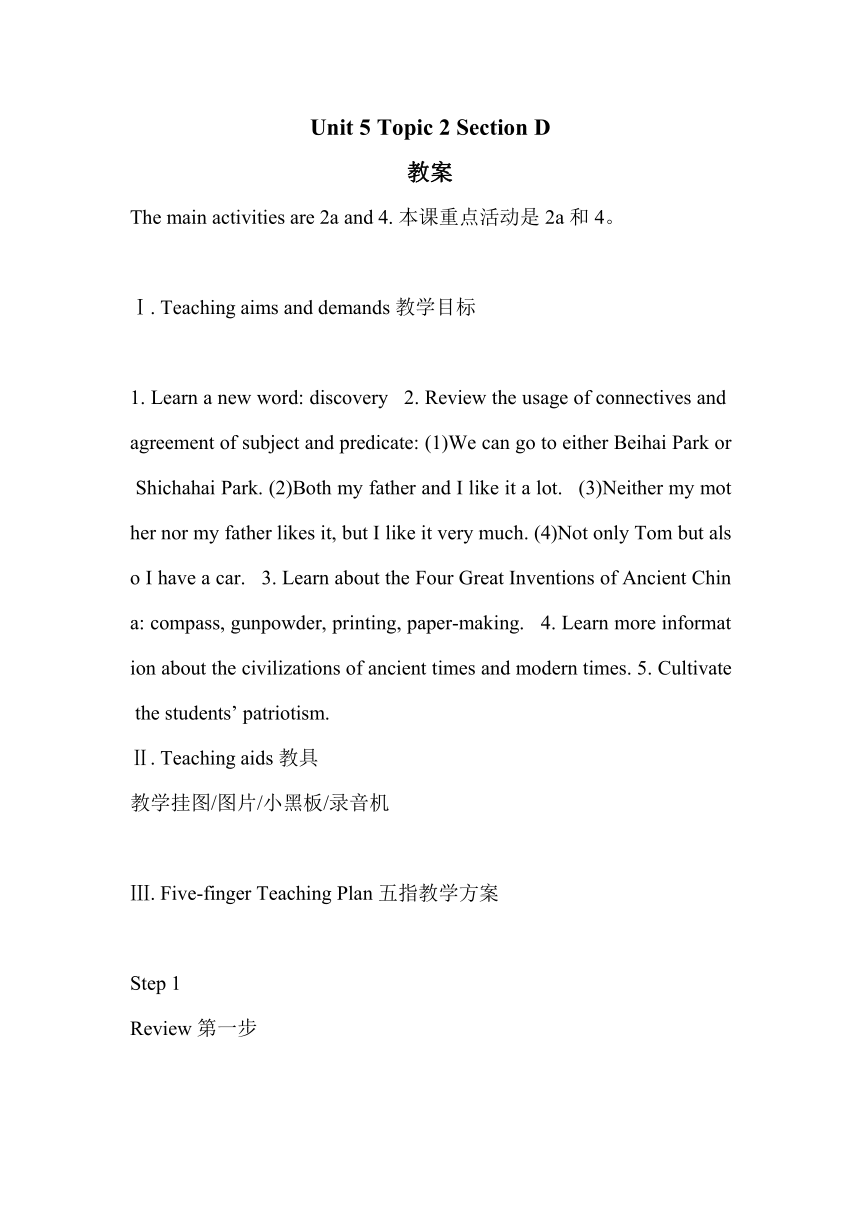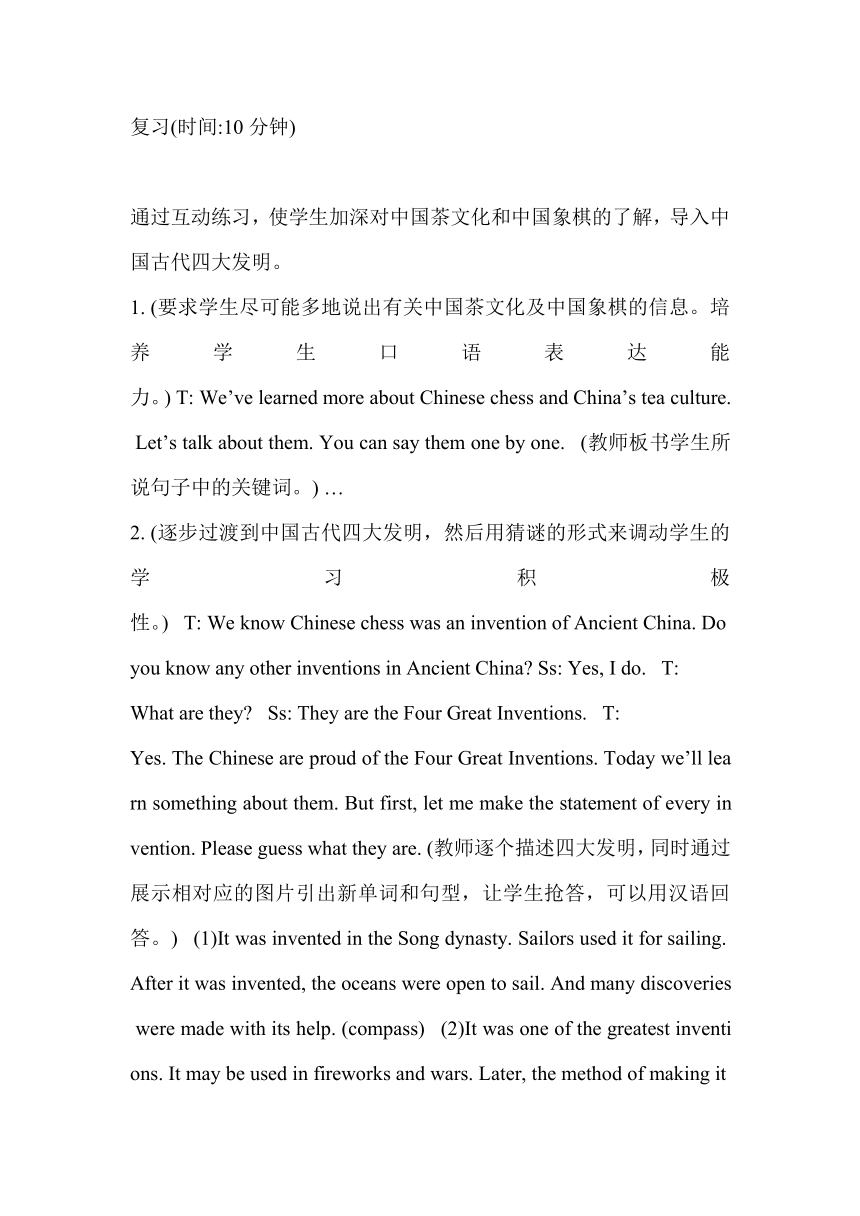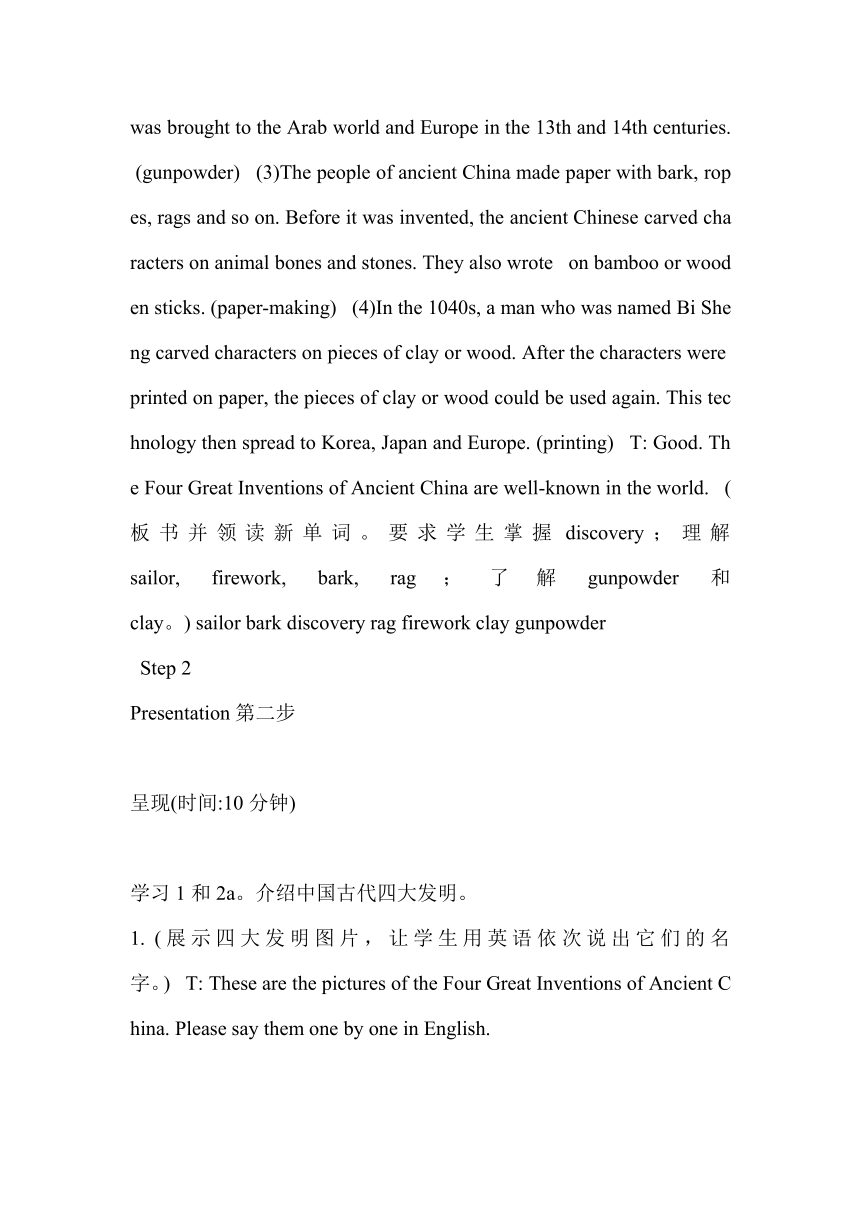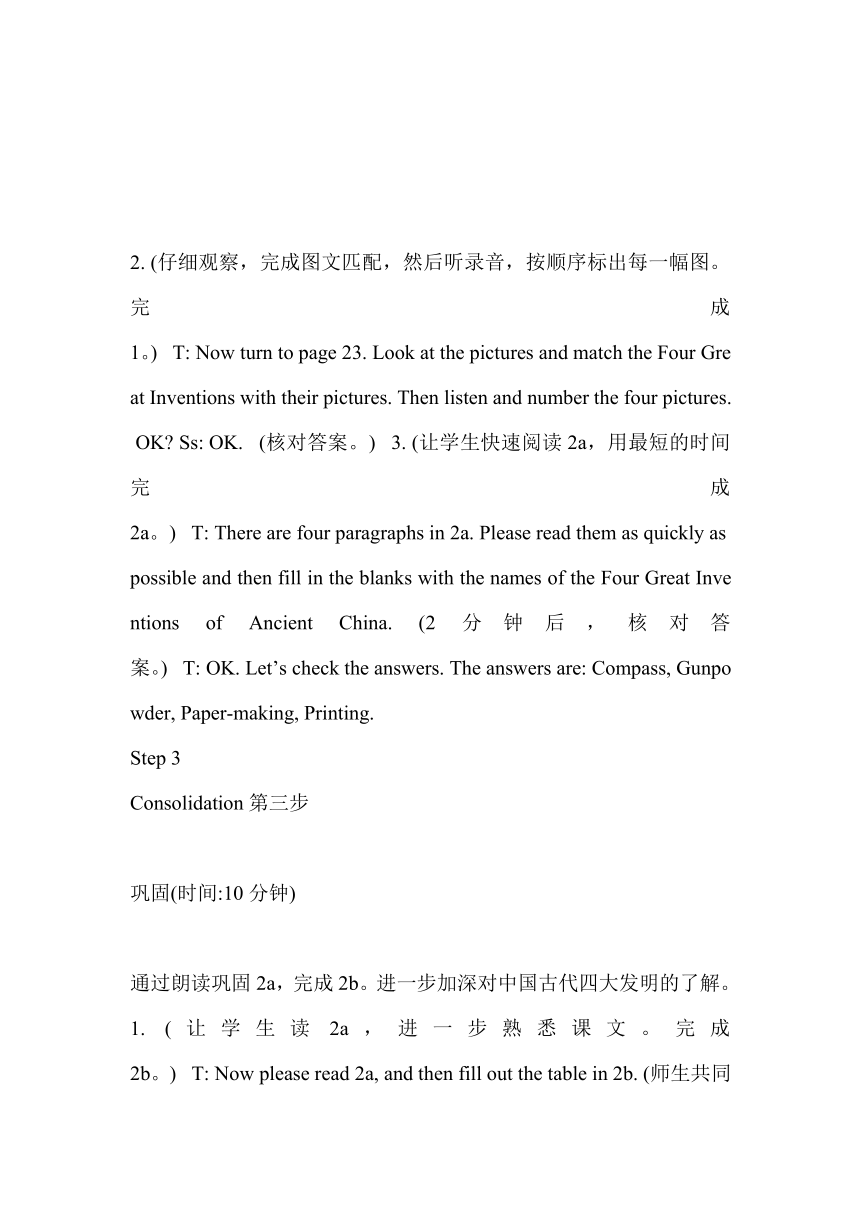Unit 5 China and the world.Topic 2 He is really the pride of China. Section D 教案
文档属性
| 名称 | Unit 5 China and the world.Topic 2 He is really the pride of China. Section D 教案 |  | |
| 格式 | zip | ||
| 文件大小 | 121.4KB | ||
| 资源类型 | 教案 | ||
| 版本资源 | 仁爱科普版 | ||
| 科目 | 英语 | ||
| 更新时间 | 2017-11-06 21:21:51 | ||
图片预览




文档简介
Unit
5
Topic
2
Section
D
教案
The main activities are 2a and 4. 本课重点活动是2a和4。
Ⅰ. Teaching aims and demands教学目标
1. Learn a new word: discovery
2. Review the usage of connectives and agreement of subject and predicate: (1)We can go to either Beihai Park or Shichahai Park. (2)Both my father and I like it a lot.
(3)Neither my mother nor my father likes it, but I like it very much. (4)Not only Tom but also I have a car.
3. Learn about the Four Great Inventions of Ancient China: compass, gunpowder, printing, paper-making.
4. Learn more information about the civilizations of ancient times and modern times. 5. Cultivate the students’ patriotism.
Ⅱ. Teaching aids教具
教学挂图/图片/小黑板/录音机
Ⅲ. Five-finger Teaching Plan五指教学方案
Step 1
Review 第一步
复习(时间:10分钟)
通过互动练习,使学生加深对中国茶文化和中国象棋的了解,导入中国古代四大发明。
1. (要求学生尽可能多地说出有关中国茶文化及中国象棋的信息。培养学生口语表达能力。) T: We’ve learned more about Chinese chess and China’s tea culture. Let’s talk about them. You can say them one by one.
(教师板书学生所说句子中的关键词。) …
2. (逐步过渡到中国古代四大发明,然后用猜谜的形式来调动学生的学习积极性。)
T: We know Chinese chess was an invention of Ancient China. Do you know any other inventions in Ancient China Ss: Yes, I do.
T:
What are they
Ss: They are the Four Great Inventions.
T:
Yes. The Chinese are proud of the Four Great Inventions. Today we’ll learn something about them. But first, let me make the statement of every invention. Please guess what they are. (教师逐个描述四大发明,同时通过展示相对应的图片引出新单词和句型,让学生抢答,可以用汉语回答。)
(1)It was invented in the Song dynasty. Sailors used it for sailing. After it was invented, the oceans were open to sail. And many discoveries were made with its help. (compass)
(2)It was one of the greatest inventions. It may be used in fireworks and wars. Later, the method of making it was brought to the Arab world and Europe in the 13th and 14th centuries. (gunpowder)
(3)The people of ancient China made paper with bark, ropes, rags and so on. Before it was invented, the ancient Chinese carved characters on animal bones and stones. They also wrote
on bamboo or wooden sticks. (paper-making)
(4)In the 1040s, a man who was named Bi Sheng carved characters on pieces of clay or wood. After the characters were printed on paper, the pieces of clay or wood could be used again. This technology then spread to Korea, Japan and Europe. (printing)
T: Good. The Four Great Inventions of Ancient China are well-known in the world.
(板书并领读新单词。要求学生掌握discovery;理解sailor, firework, bark, rag;了解gunpowder和clay。) sailor bark discovery rag firework clay gunpowder
Step 2
Presentation 第二步
呈现(时间:10分钟)
学习1和2a。介绍中国古代四大发明。
1. (展示四大发明图片,让学生用英语依次说出它们的名字。)
T: These are the pictures of the Four Great Inventions of Ancient China. Please say them one by one in English.
2. (仔细观察,完成图文匹配,然后听录音,按顺序标出每一幅图。完成1。)
T: Now turn to page 23. Look at the pictures and match the Four Great Inventions with their pictures. Then listen and number the four pictures. OK Ss: OK.
(核对答案。)
3. (让学生快速阅读2a,用最短的时间完成2a。)
T: There are four paragraphs in 2a. Please read them as quickly as possible and then fill in the blanks with the names of the Four Great Inventions of Ancient China. (2分钟后,核对答案。)
T: OK. Let’s check the answers. The answers are: Compass, Gunpowder, Paper-making, Printing.
Step 3
Consolidation 第三步
巩固(时间:10分钟)
通过朗读巩固2a,完成2b。进一步加深对中国古代四大发明的了解。
1. (让学生读2a,进一步熟悉课文。完成2b。)
T: Now please read 2a, and then fill out the table in 2b. (师生共同核对答案。)
2. (让学生分四组朗读短文,然后每组选一个代表,有感情地朗读短文的一个段落。)
T: Now, I’ll divide all the students into four groups. Next, read 2a in groups. And then I’ll ask one student of each group to read one paragraph aloud, understand Ss: Yes.
T: OK, S1 stands for Group One. S2 stands for Group Two. S3 stands for Group Three. S4 stands for Group Four.
(学生代表朗读,其他学生给予鼓掌、喝彩,活跃课堂气氛,最后教师作总评。)
3. (让这四组学生分别代表火药、造纸术、印刷术和指南针,并把自己组所代表的发明介绍给别人。)
T: Group One stands for gunpowder. Group Two stands for paper-making. Group Three stands for printing. Group Four stands for compass. Then introduce yourself to the others, please. (鼓励学生用自己的语言进行介绍,教师对表达完整的小组给予表扬。)
Step 4
Practice 第四步
练习(时间:10分钟)
练习3a,3b,归纳、复习连词的用法及其主谓一致的原则和本话题有用的表达方式。
1. (练习3a。)
T: Let’s come to the Grammar focus. In this topic we have learned the usage of connectives. (板书,复习连词的用法,提醒学生注意连接并列主语时,主谓要一致。) either … or …
both … and …
neither … nor …
not only … but also …
2. (出示小黑板,要求学生完成小黑板上的连词练习。) T: Do the exercises. Join two sentences with connectives. (1)I can’t swim. He can’t swim, either.
(2)You may stay at home. Or you may go to see the movie. (3)Shenzhou Ⅴ
has been sent up into space. Shenzhou Ⅵ
has also been sent up.
(让学生到黑板上演示,然后师生一起核对答案。)
3. (教师先放3b的录音,让学生跟读。然后让学生合上课本,教师说汉语,学生依次把英语说出。完成3b。)
T: First, listen to the tape and read after it. Then close your books, please. I say them one by one in Chinese. You express them in English.
4. (师生一起就本话题所了解的中国古文化知识进行归纳、总结。)
T: OK. Well done. Let’s sum up the knowledge that we have learned in this topic together. Example:
T: First, we have learned something about the Forbidden City,the stories of dragons and Huabiao, etc.
(让学生以同样的方式归纳Section B,C,D的内容。) The Forbidden City: The stories of dragons and Huabiao:
S1: Dragons are carved on the
stones.
S2: There are many interesting
stories about Huabiao. S3: …
Chinese chess: S4: …
Chinese tea: S5: …
The Four Great Inventions: S6: …
Step 5
Project 第五步
综合探究活动(时间:5分钟)
让学生分组收集整理关于中国古代文明和现代文明的资料,完成4。
1. (将学生分成两组。一组收集关于中国古代文明的相关资料,另一组收集关于中国现代文明的相关资料。)
T: Group A stands for the ancient times. Group B stands for the modern times. Then collect information about the civilizations of the two periods, including culture, famous people, technologies and inventions, etc.
2. (让各组学生向全班同学展示收集的资料,看哪一组收集的资料多,教师板书关键词。) T: Please list the information you collect and see which group collects more.
(板书)
Group 1: S1:
S2:
…
Group 2: S3:
S4:
…
3. Homework:
Write a passage about the civilizations of China’s ancient times and modern times, including culture, famous people, technologies, inventions, etc.
板书设计:
The dragon has become a symbol of the Chinese nation.
Section D
gunpowder either … or …
printing both … and …
paper-making neither … nor …
compass not only … but also …
discovery
the Four Great
Inventions of
Ancient China
5
Topic
2
Section
D
教案
The main activities are 2a and 4. 本课重点活动是2a和4。
Ⅰ. Teaching aims and demands教学目标
1. Learn a new word: discovery
2. Review the usage of connectives and agreement of subject and predicate: (1)We can go to either Beihai Park or Shichahai Park. (2)Both my father and I like it a lot.
(3)Neither my mother nor my father likes it, but I like it very much. (4)Not only Tom but also I have a car.
3. Learn about the Four Great Inventions of Ancient China: compass, gunpowder, printing, paper-making.
4. Learn more information about the civilizations of ancient times and modern times. 5. Cultivate the students’ patriotism.
Ⅱ. Teaching aids教具
教学挂图/图片/小黑板/录音机
Ⅲ. Five-finger Teaching Plan五指教学方案
Step 1
Review 第一步
复习(时间:10分钟)
通过互动练习,使学生加深对中国茶文化和中国象棋的了解,导入中国古代四大发明。
1. (要求学生尽可能多地说出有关中国茶文化及中国象棋的信息。培养学生口语表达能力。) T: We’ve learned more about Chinese chess and China’s tea culture. Let’s talk about them. You can say them one by one.
(教师板书学生所说句子中的关键词。) …
2. (逐步过渡到中国古代四大发明,然后用猜谜的形式来调动学生的学习积极性。)
T: We know Chinese chess was an invention of Ancient China. Do you know any other inventions in Ancient China Ss: Yes, I do.
T:
What are they
Ss: They are the Four Great Inventions.
T:
Yes. The Chinese are proud of the Four Great Inventions. Today we’ll learn something about them. But first, let me make the statement of every invention. Please guess what they are. (教师逐个描述四大发明,同时通过展示相对应的图片引出新单词和句型,让学生抢答,可以用汉语回答。)
(1)It was invented in the Song dynasty. Sailors used it for sailing. After it was invented, the oceans were open to sail. And many discoveries were made with its help. (compass)
(2)It was one of the greatest inventions. It may be used in fireworks and wars. Later, the method of making it was brought to the Arab world and Europe in the 13th and 14th centuries. (gunpowder)
(3)The people of ancient China made paper with bark, ropes, rags and so on. Before it was invented, the ancient Chinese carved characters on animal bones and stones. They also wrote
on bamboo or wooden sticks. (paper-making)
(4)In the 1040s, a man who was named Bi Sheng carved characters on pieces of clay or wood. After the characters were printed on paper, the pieces of clay or wood could be used again. This technology then spread to Korea, Japan and Europe. (printing)
T: Good. The Four Great Inventions of Ancient China are well-known in the world.
(板书并领读新单词。要求学生掌握discovery;理解sailor, firework, bark, rag;了解gunpowder和clay。) sailor bark discovery rag firework clay gunpowder
Step 2
Presentation 第二步
呈现(时间:10分钟)
学习1和2a。介绍中国古代四大发明。
1. (展示四大发明图片,让学生用英语依次说出它们的名字。)
T: These are the pictures of the Four Great Inventions of Ancient China. Please say them one by one in English.
2. (仔细观察,完成图文匹配,然后听录音,按顺序标出每一幅图。完成1。)
T: Now turn to page 23. Look at the pictures and match the Four Great Inventions with their pictures. Then listen and number the four pictures. OK Ss: OK.
(核对答案。)
3. (让学生快速阅读2a,用最短的时间完成2a。)
T: There are four paragraphs in 2a. Please read them as quickly as possible and then fill in the blanks with the names of the Four Great Inventions of Ancient China. (2分钟后,核对答案。)
T: OK. Let’s check the answers. The answers are: Compass, Gunpowder, Paper-making, Printing.
Step 3
Consolidation 第三步
巩固(时间:10分钟)
通过朗读巩固2a,完成2b。进一步加深对中国古代四大发明的了解。
1. (让学生读2a,进一步熟悉课文。完成2b。)
T: Now please read 2a, and then fill out the table in 2b. (师生共同核对答案。)
2. (让学生分四组朗读短文,然后每组选一个代表,有感情地朗读短文的一个段落。)
T: Now, I’ll divide all the students into four groups. Next, read 2a in groups. And then I’ll ask one student of each group to read one paragraph aloud, understand Ss: Yes.
T: OK, S1 stands for Group One. S2 stands for Group Two. S3 stands for Group Three. S4 stands for Group Four.
(学生代表朗读,其他学生给予鼓掌、喝彩,活跃课堂气氛,最后教师作总评。)
3. (让这四组学生分别代表火药、造纸术、印刷术和指南针,并把自己组所代表的发明介绍给别人。)
T: Group One stands for gunpowder. Group Two stands for paper-making. Group Three stands for printing. Group Four stands for compass. Then introduce yourself to the others, please. (鼓励学生用自己的语言进行介绍,教师对表达完整的小组给予表扬。)
Step 4
Practice 第四步
练习(时间:10分钟)
练习3a,3b,归纳、复习连词的用法及其主谓一致的原则和本话题有用的表达方式。
1. (练习3a。)
T: Let’s come to the Grammar focus. In this topic we have learned the usage of connectives. (板书,复习连词的用法,提醒学生注意连接并列主语时,主谓要一致。) either … or …
both … and …
neither … nor …
not only … but also …
2. (出示小黑板,要求学生完成小黑板上的连词练习。) T: Do the exercises. Join two sentences with connectives. (1)I can’t swim. He can’t swim, either.
(2)You may stay at home. Or you may go to see the movie. (3)Shenzhou Ⅴ
has been sent up into space. Shenzhou Ⅵ
has also been sent up.
(让学生到黑板上演示,然后师生一起核对答案。)
3. (教师先放3b的录音,让学生跟读。然后让学生合上课本,教师说汉语,学生依次把英语说出。完成3b。)
T: First, listen to the tape and read after it. Then close your books, please. I say them one by one in Chinese. You express them in English.
4. (师生一起就本话题所了解的中国古文化知识进行归纳、总结。)
T: OK. Well done. Let’s sum up the knowledge that we have learned in this topic together. Example:
T: First, we have learned something about the Forbidden City,the stories of dragons and Huabiao, etc.
(让学生以同样的方式归纳Section B,C,D的内容。) The Forbidden City: The stories of dragons and Huabiao:
S1: Dragons are carved on the
stones.
S2: There are many interesting
stories about Huabiao. S3: …
Chinese chess: S4: …
Chinese tea: S5: …
The Four Great Inventions: S6: …
Step 5
Project 第五步
综合探究活动(时间:5分钟)
让学生分组收集整理关于中国古代文明和现代文明的资料,完成4。
1. (将学生分成两组。一组收集关于中国古代文明的相关资料,另一组收集关于中国现代文明的相关资料。)
T: Group A stands for the ancient times. Group B stands for the modern times. Then collect information about the civilizations of the two periods, including culture, famous people, technologies and inventions, etc.
2. (让各组学生向全班同学展示收集的资料,看哪一组收集的资料多,教师板书关键词。) T: Please list the information you collect and see which group collects more.
(板书)
Group 1: S1:
S2:
…
Group 2: S3:
S4:
…
3. Homework:
Write a passage about the civilizations of China’s ancient times and modern times, including culture, famous people, technologies, inventions, etc.
板书设计:
The dragon has become a symbol of the Chinese nation.
Section D
gunpowder either … or …
printing both … and …
paper-making neither … nor …
compass not only … but also …
discovery
the Four Great
Inventions of
Ancient China
同课章节目录
- Unit 5 China and the world
- Topic 1 China attracts millions of tourists from a
- Topic 2 He is really the pride of China.
- Topic 3 Now it is a symbol of England.
- Unit 6 Entertainment and Friendship.
- Topic 1 I would rather watch sports shows than tho
- Topic 2 Who is your favorite character in literatu
- Topic 3 I will remember our friendship forever.
